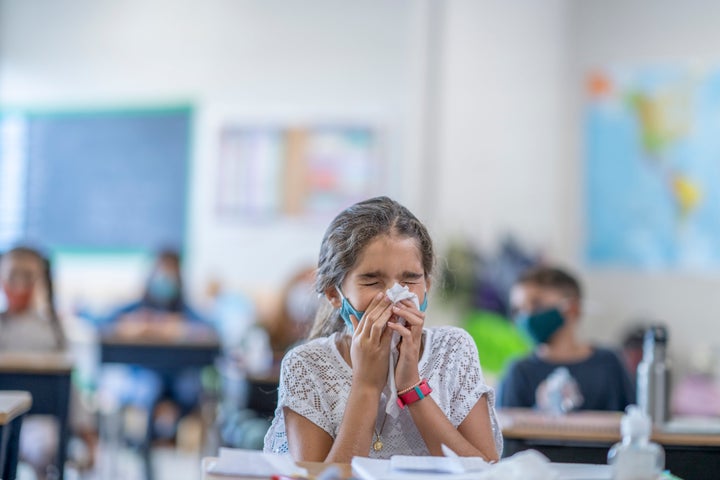
It’ll come as a surprise to absolutely no one that schools are germy. Kids frequently pick up colds, stomach bugs and more ― and the same goes for teachers, school staff and parents.
While viruses can float in the air ― as we know from COVID-19 ― they also exist on surfaces in schools and other public spaces.
“In general, the germiest places and surfaces are going to be things that are repeatedly touched by multiple people without cleaning,” Dr. S. Wesley Long, the medical director of diagnostic microbiology at Houston Methodist Hospital, told HuffPost via email.
According to Dr. Anne Liu, clinical associate professor of infectious diseases at Stanford Medicine in California, this goes for both respiratory viruses (like COVID, RSV and the flu) and norovirus, which is more casually known as the stomach bug.
Below, doctors share the germiest places in schools and how to protect kids from getting sick.
Door Handles
As mentioned above, high-touch surfaces are really germy — and this goes for door handles, which are touched by essentially every person in a class.
“People will cough into their hand as they’re walking into a classroom and then open the door and then right after them come the other kids and all touching the same surfaces,” Liu said.
According to Liu, if a long period of time passes between door handle touches, there is less risk for virus spread. But for somewhere like a school ― where students are likely heading into a classroom back to back ― there isn’t time for the amount of virus on a handle to decrease.
“Especially during the seasons when kids who are having symptoms and coughing and sneezing into their hands, those [high-touch] objects will probably carry a lot of transmissible viable virus,” Liu added.
Liu noted that kids, particularly, have a hard time refraining from unconsciously touching their faces, which can allow sicknesses picked up from places like door handles to spread into their mouths, eyes or noses. She stressed that it’s important to teach children about the importance of proper handwashing ahead of back-to-school season.
Water Fountains
“Multiple studies have shown that water fountains can be a place where microbes congregate, as the human mouth is loaded with bacteria, and water tends to splash onto the faucet from the face and mouth,” Long said.
Additionally, these are one of those shared high-touch surfaces that carry an increased risk for virus spread.
Just think about it: Lots of kids touch the water fountain every day, whether they’re getting a sip of water or filling up their reusable water bottles.

Shared Keyboards And Shared Computer Mice
According to Liu, other high-touch shared objects like any communal keyboards or computer mice are also red flags for germ spread. This could be computers in the school library or even a computer used for student presentations.
It’s important that children (and teachers!) sanitize or wash their hands after putting their hands on these potentially grubby surfaces.
Reusable Cafeteria Trays
While cafeteria plates and cups get washed after every use, the same isn’t always said for reusable cafeteria trays.
They’re touched by lots of different students without cleaning, which makes them a germy item. According to Long, these reusable trays can be “sources of infection.”
Note: bathrooms aren’t as germy as you’d think.
“Interestingly, restroom surfaces are often cleaned frequently, so restrooms may be one of the cleanest locations in a school,” Long said. (But it’s still crucial to wash your hands after using the bathroom.)
But while bathrooms themselves aren’t as dirty as often assumed, the door handles can be, Long noted.
Beyond surfaces, viruses can spread through droplets in the air, too.
“Of course, when doors and windows are closed in the fall in winter, then the air carries viruses and droplets,” Liu said. “And we have seen how transmissible some of those respiratory viruses can be.”
She noted that respiratory viruses are largely spread by people hanging out near each other (which certainly happens in schools) by coughing, sneezing and even just breathing.
Because of this, it’s important for students, teachers and school staff to stay home when they’re sick or at the very least wear a mask, said Dr. Philip J. Landrigan, the director of the Program for Global Public Health and the Common Good at Boston College.
“Masks are still very useful means of reducing the spread of infection in the school,” Landrigan said.
Landrigan added that the whole school environment is a breeding ground for virus spread. “It’s no accident that all sorts of respiratory diseases that are pretty infrequent during the summer increase in frequency within a few weeks after the start of school,” he noted — and this isn’t a new post-pandemic trend, this has been the case for decades.
There are ways for students and teachers to stay healthy.
Staying home when you’re sick is key to preventing the spread of germs. If you’re unable to do that, wear a mask ― especially when you’re coughing or sneezing.
Additionally, hand-washing with soap and water is important. “Hand sanitizer doesn’t kill norovirus, which is the most common form of community-acquired gastroenteritis or diarrheal illness,” Liu said. “Hand-washing with soap and water is really needed to reduce norovirus.”
Vaccination is also a good way for students, teachers and their families to stay healthy. “Every child, except those who have some medical contraindication, should be vaccinated against COVID, against RSV and against influenza, the big three viruses,” Landrigan said.
Long noted that beyond this, kids should complete their regular childhood vaccine series, which can be sorted out with their doctor.
And if a child does catch a virus of some sort, it’s important to stay on top of it. “If a child does develop a respiratory infection and it looks like it’s more than a mild cold they should definitely visit their pediatrician [or] visit their nurse practitioner,” Landrigan said.